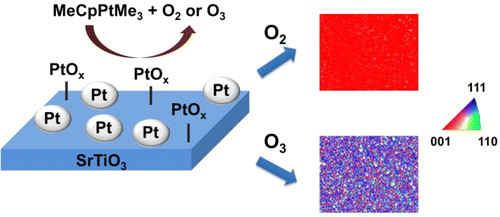当前位置:
X-MOL 学术
›
Chem. Mater.
›
论文详情
Our official English website, www.x-mol.net, welcomes your
feedback! (Note: you will need to create a separate account there.)
Orientation-Controlled Growth of Pt Films on SrTiO3 (001) by Atomic Layer Deposition
Chemistry of Materials ( IF 7.2 ) Pub Date : 2015-09-17 00:00:00 , DOI: 10.1021/acs.chemmater.5b03007 Jung Joon Pyeon 1, 2 , Jun-Yun Kang 3 , Seung-Hyub Baek 1, 4 , Chong-Yun Kang 1, 2 , Jin-Sang Kim 1 , Doo Seok Jeong 1, 4 , Seong Keun Kim 1, 4
Chemistry of Materials ( IF 7.2 ) Pub Date : 2015-09-17 00:00:00 , DOI: 10.1021/acs.chemmater.5b03007 Jung Joon Pyeon 1, 2 , Jun-Yun Kang 3 , Seung-Hyub Baek 1, 4 , Chong-Yun Kang 1, 2 , Jin-Sang Kim 1 , Doo Seok Jeong 1, 4 , Seong Keun Kim 1, 4
Affiliation

|
We grew Pt films on TiO2-terminated SrTiO3 (001) by atomic layer deposition, using trimethyl(methylcyclopentadienyl)-platinum(IV) as the Pt source and O2 and O3 as the oxidants. The orientation of the Pt films grown with O2 varied from (111) to (001) as the growth temperature was increased from 220 to 350 °C, while the Pt films grown with O3 have a strong preference for the (111) orientation even at a high growth temperature of 350 °C. The difference in the orientation of the Pt films on SrTiO3 (001) was attributed to changes in the degree of chemical bonding across the Pt/SrTiO3 interface with respect to the oxidant. We observed an increase in Pt–O bonding at the interface between the Pt grown with O3 and the SrTiO3 substrate. The interfacial energy of Pt (111)∥SrTiO3 (001) may have been significantly decreased by the increase in Pt–O bonding at the interface, which eventually led to the strong (111) preference of the Pt grown with O3. The findings provide the possibility of controlling the orientation of Pt without manipulating the kinetic energy of crystal growth.
中文翻译:

原子层沉积在SrTiO 3(001)上Pt膜的取向控制生长
我们使用三甲基(甲基环戊二烯基)-铂(IV)作为Pt源,并使用O 2和O 3作为氧化剂,通过原子层沉积法在TiO 2终止的SrTiO 3(001)上生长了Pt膜。随着生长温度从220°C升高到350°C,用O 2生长的Pt膜的取向从(111)变为(001),而用O 3生长的Pt膜对(111)取向有强烈的偏好即使在350°C的高生长温度下也是如此。SrTiO 3(001)上Pt膜取向的差异归因于Pt / SrTiO 3上化学键合度的变化相对于氧化剂的界面。我们观察到在O 3和SrTiO 3衬底生长的Pt之间的界面处Pt-O键的增加。铂的界面能(111)∥SrTiO 3(001)可能已被显著通过在界面处的增加的Pt-O键合,最终导致在Pt生长的强(111)首选项与O-减少3。这些发现提供了在不操纵晶体生长的动能的情况下控制Pt取向的可能性。
更新日期:2015-09-17
中文翻译:

原子层沉积在SrTiO 3(001)上Pt膜的取向控制生长
我们使用三甲基(甲基环戊二烯基)-铂(IV)作为Pt源,并使用O 2和O 3作为氧化剂,通过原子层沉积法在TiO 2终止的SrTiO 3(001)上生长了Pt膜。随着生长温度从220°C升高到350°C,用O 2生长的Pt膜的取向从(111)变为(001),而用O 3生长的Pt膜对(111)取向有强烈的偏好即使在350°C的高生长温度下也是如此。SrTiO 3(001)上Pt膜取向的差异归因于Pt / SrTiO 3上化学键合度的变化相对于氧化剂的界面。我们观察到在O 3和SrTiO 3衬底生长的Pt之间的界面处Pt-O键的增加。铂的界面能(111)∥SrTiO 3(001)可能已被显著通过在界面处的增加的Pt-O键合,最终导致在Pt生长的强(111)首选项与O-减少3。这些发现提供了在不操纵晶体生长的动能的情况下控制Pt取向的可能性。


















































 京公网安备 11010802027423号
京公网安备 11010802027423号